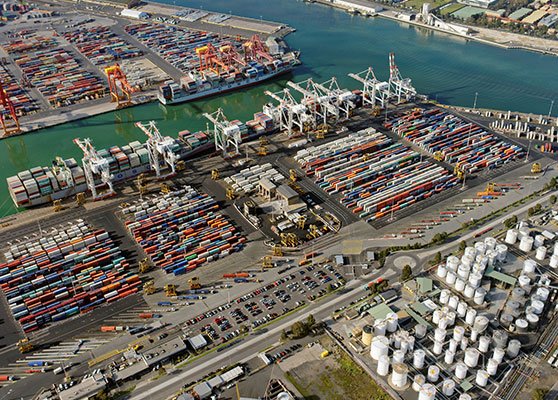Property investment is popular among a wide range of investors. From ‘Mum-and-Dad’ investors to professional Portfolio Managers, real estate investments offer the potential for consistent cash income and long-term capital growth returns, as well as favourable tax treatment in some cases.
While many commentators often simply refer to a single ‘property market’, the reality is that real estate is a diverse marketplace with a range of assets that appeal to investors with different amounts of capital, and varying appetites for risk.
Broadly speaking, property can be divided into three asset classes – residential, commercial and industrial but when it comes to making an investment decision, how can investors choose the right asset, or mix of assets?
We’re exploring the pros and cons that come into play for each key type of property investment.

Residential property investment
Australia has always had a love affair with residential property investment, with the “Australian dream” often centred around the purchase of a property for their home.
According to the most recent census, while 65% of homes belong to owner-occupiers, a large portion, 30.9% of homes are being rented, meaning investors control a large portion of the Australian residential property market.
Are these 30.9% of investors onto something good?
Pros
Residential property can make for an attractive investment as it’s likely to provide consistent, weekly rental income, and lease agreements are very straightforward.
Additionally, ease of renovations that improve or personalise a residential property, such as an extra bedroom, pool or patio, can create further value and increase the potential for significant long-term returns. According to Corelogic, the median house prices in Sydney and Melbourne have risen by 44.1% and 39.1% respectively over the decade to 2017, when adjusted for inflation. The costs of entry into the residential property market is also relatively low, when compared with other property asset classes.
Cons
However, like most investments, there are risks associated with investing in housing. When making a residential property investment, investors can risk putting all their financial ‘eggs’ in one basket, investing a large sum of money in the one asset.
While investors may be attracted to property by rising median values, it’s quite possible that while some values in one area may be rising, in another, local factors can cause values to decline significantly, leading to losses for investors. Unemployment, crime, a lack of public amenities or access to transport, shops, schools or heath care services can influence a suburb’s appeal and cause a price slump. Even something as simple as the attractiveness of the area from street level cannot be underestimated for its impact on property prices. If a house, or others on the same street, do not maintain aesthetic appeal, tens of thousands of dollars can be stripped from their value.
Investors with only one investment property are more exposed to this sort of local variation, as they may not be in a financial position to diversify their risk across geographies.
Furthermore, investors who are looking for liquidity should consider carefully the risks and costs of direct investment in housing. The challenges and costs associated with the sale of a residential property, including finding the right buyer as well as government fees and duties mean transaction costs are high for residential properties.
Alternatively, investors looking for exposure to the residential property market could also consider an investment in a mortgage trust. This investment option lends investor money to borrowers in exchange for a registered first mortgage over improved or unimproved property as the primary security, creating a shared risk environment for investors. Advantageously, mortgage trusts provide a higher yield than that of direct residential property ownership, however, keep in mind this investment option won’t provide the opportunity for capital growth, and of course each has their own risks attached.
Commercial and industrial property investment
While much of the public commentary in Australia centres around the housing market, retail commercial and industrial property investment offer investors a different type of ‘bricks and mortar’ asset. Hotels, restaurants, office buildings, business parks, warehouses, factories and clinics can all offer competitive returns through rental income and capital growth.
Should commercial or industrial property be the next addition to your investment portfolio?
Pros
In May this year, the Reserve Bank of Australia (RBA) predicted economic growth to be above 3% from late-2018. Business conditions were also labelled as positive, with surveys held across a broad range of sectors suggesting expansion is set to continue.

With a strong economy comes business growth, and with growth comes demand for space to conduct business, sell products and services, manufacture and store goods, and conduct research and development activities. Industrial warehouses and distribution centres are becoming ever popular as businesses move away from traditional retail set-ups to online store fronts.
While many residential investors bet their investment on strong capital returns due to the relatively low 3-4% annual yield, according to research from Corelogic, commercial properties can deliver yields around say 7% p.a. and in rare cases as high as 10% p.a. with higher risk – making for more attractive annual income.
Commercial leases traditionally also run for significantly longer terms. While the costs associated with drawing up a unique lease may exceed those of a residential tenancy agreement (due to the potential for more varied terms in commercial agreements), a commercial lessor often has the security of a 5 or 10-year agreement. This minimises advertising costs, much reduced vacancy risk and creates greater certainty for the investor. This is particularly true for large commercial and industrial tenants whose operations often require long term leases to justify the extensive capital costs of setting up an operation.
Similar to residential property, you can also seek to add value to your commercial property through renovation, upgrading, subdivision or the improvement of existing facilities.
Cons
The upfront capital cost of a commercial or industrial property investment can often be a deterrent for investors. Further, investors looking to diversify their risk may baulk at the prospect of locking away large amounts of capital in one asset.
Investors who are looking for a foot in the door of the commercial or industrial property market may look to a property trust, which seeks to provide stable, regular income and the potential for long-term capital growth for a fraction of the capital required for a single asset via direct ownership.
Used astutely, property could form an integral part of your overall strategy to build wealth. Whichever property investment path you choose, it’s important to take your time and seek advice from a licensed Financial Adviser who can develop an investment strategy tailored to your personal circumstances, financial situation and investment goals.
For more on investing, check out the 7 habits of highly effective investors or if you’re looking to further explore property trusts as part of your investment portfolio, learn more about what to look for in you next unlisted property trust.
This advice is general advice only and does not consider your objectives, financial situation or needs. You should consider whether the advice is suitable for you and your personal circumstances and we recommend that you seek personal financial product advice on your objectives, financial situation or needs and obtain and read the relevant product disclosure statement before making any investment decision.

